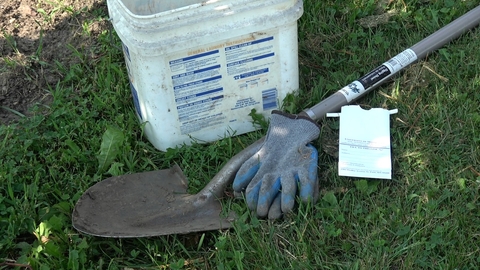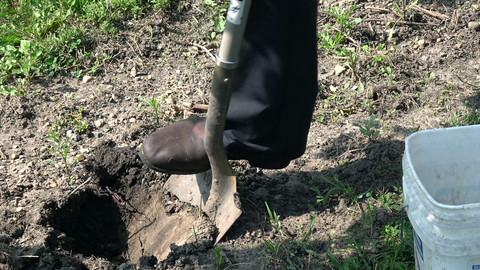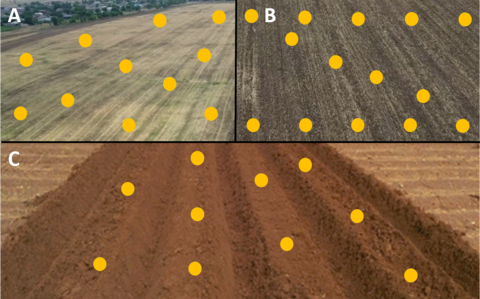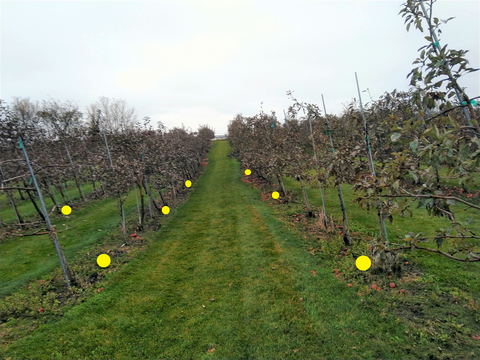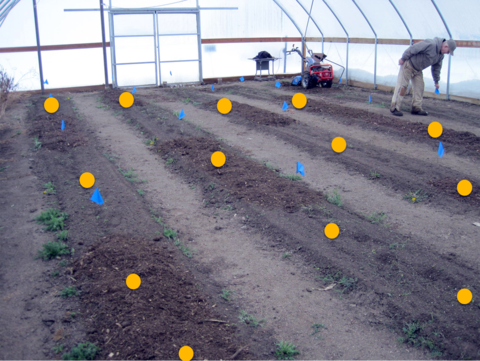Quick facts
- Soil testing should be done every 1 to 5 years in specialty crops, depending on the crop.
- Try to sample at the same time every year, to allow for better comparisons over time.
- Collect a representative sample containing soil from throughout the area of interest.
- Submit samples to the UMN Soil Testing Laboratory for analysis and recommendations.
- Resources are available from UMN Extension to assist with interpreting a soil report.
Soil testing is a foundation for nutrient management. A soil test provides baseline information about the amounts of nutrients available in your soil, and what is needed for healthy plant growth.
Specialty crop growers should test their soil at least every 2-3 years, and every year in high-value production environments such as high tunnels. Testing every 3-5 years is sufficient for perennials like berries, orchards and grapes, but more frequent testing is useful for diagnosing problems or evaluating recent amendments.
For more information regarding proper procedures and timing for plant tissue sampling, refer to our page on foliar testing.
Soil testing: Why, when and how?
A soil test provides information specific to your crops and soil. It also incorporates past cropping history, giving you nitrogen "credit" for legume crops incorporated into your rotation. You can save time, money and angst by getting lime and fertilizer recommendations rather than guessing what might be best.
By applying only what is needed, you will also minimize any adverse environmental impacts from fertilizer overuse. Excess soil nutrients contribute to problems such as algal growth in lakes (too much phosphorus) or nitrates in groundwater (too much nitrogen). And while you can buy home soil test kits, they are not calibrated to the soil characteristics we have in Minnesota, nor do they provide recommendations specific to your situation.
Sampling before or after planting is generally most convenient, such as in early spring or late fall. With diverse crop rotations in vegetables, you may prefer other times of the year.
Try to sample at the same time each year, in order to get good comparisons across years. If you suspect a severe nutrient deficiency during the season, you can also sample at that time, but it may be too late to completely 'fix' a deficiency once crops have shown symptoms. However, you may still be able to improve overall growth and be better prepared for the following year.
The video below shows how to take a soil sample on a vegetable farm and walks through the dynamics of deciding how many separate tests to get.
In general, take a representative sample from an area with fairly uniform soil color and texture as well as similar cropping history, including fertilizer, lime, and manure applications.
Samples should represent no more than 20-25 acres, and no more than 5 acres if the area is hilly, has highly variable drainage, or other obvious inconsistencies. Sample to a depth of 6 inches using a soil probe or a handheld trowel.
Collect 15-30 subsamples in either a random pattern (A) or zig-zag pattern (B) across the entire area. You'll need fewer samples in more uniform areas and more in highly variable areas. In outdoor raised beds, collect samples from the beds rather than from areas between beds (C).
This video shows how to take a soil sample in an orchard or a vineyard.
- In general, when gathering soil samples in an orchard or vineyard, collect samples within rows, between the plants (see photo below).
- Take 15-30 subsamples within a representative area — usually 5 acres or less, depending on variability in topography as well as soil and plant growth characteristics.
- Sample to a depth of 8-12 inches using a soil probe or a handheld trowel. If the field has more variable topography (is very hilly or contains more than one soil type) take more samples to better capture potential variability in soil qualities.
Submitting multiple samples per field, with each sample representing a different area, reveals variability in soil qualities and allows more precise nutrient management.
For perennial fruits, use soil test results in conjunction with tissue test results to manage fertility and diagnose nutrient issues.
- If sampling in a high tunnel, collect subsamples within growing beds.
- If sampling the entire tunnel area, collect at least 4-5 subsamples per bed.
- If beds are performing differently or you have varying fertility needs in each, consider analyzing soil from each bed individually.
- While it is not usually necessary to test for soluble salts in the field, growers should regularly conduct this test in their high tunnels.
Foliar testing is also important for high-tunnel fruit crops and can be valuable for high-tunnel vegetables, especially if using fertigation (applying fertilizer through irrigation water).
Choosing a soil lab
The University of Minnesota Soil Testing Laboratory offers soil tests specific to commercial fruit and vegetable growers at highly competitive prices. The 'regular series' soil test will give you estimated soil texture, organic matter, phosphorus, potassium, pH and lime requirement.
Additional tests are available for calcium and magnesium; zinc, iron, copper and manganese; and boron. Nitrate to 24 inches and sulfur are also offered but are only recommended under specific circumstances. Find instructions and a soil test submission form on the soil testing lab site.
You can also test for lead or soluble salts. While most Minnesota soils are generally considered non-saline, soluble salts can be problematic in high tunnels and should be monitored, particularly in soils that are not well-drained. While soil lead is low in Minnesota soils, the lead test is recommended for urban soils that may have been contaminated with lead.
Some farmers choose to use private labs that offer additional tests related to soil health, such as Cation Exchange Capacity (CEC). CEC measures a soil’s ability to retain exchangeable cation elements (potassium, calcium, magnesium), and some growers like to monitor changes over time. However, CEC is closely related to soil texture and organic matter and changes slowly over time. Knowing the CEC of your soil is not necessary for making nutrient recommendations; instead, recommendations are based on soil texture, % organic matter, and the concentrations of nutrients in your soil. For more information about CEC, organic matter, and soil health, refer to Soil organic matter in cropping systems.
Interpreting your results
Your soil test analysis will come with an interpretation of results and recommendations for fertilizing based on what you want to grow and your anticipated yields.
For more information about yield estimation and fruit and vegetable nutrient requirements, refer to Nutrient Management for Commercial Fruit & Vegetable Crops in Minnesota.
Growers are welcome to reach out to their local Extension educator or statewide fruit and vegetable educators for assistance with nutrient management decisions. Home gardeners should reach out to their local Master Gardener chapter or submit a question through the Ask a Master Gardener page for assistance.
Reviewed in 2024


